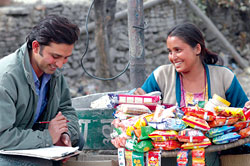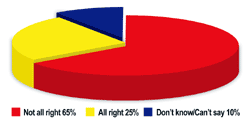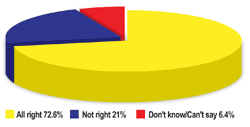|
|
A nationwide Himalmedia Public Opinion Poll 2006 conducted two weeks ago shows the Nepali people reject extremism and have some definite ideas on how to restore peace. (Right) Hiranya Baral interviews a street vendor in Bhaktapur. A surprising 53.8 percent of respondents said they were satisfied with what they were doing. Highlights:
. The Maoists and the monarchy are equally to blame for the present situation
. Direct rule by the king is not right
. Since the king has taken over, it's up to him to fix things
. The monarchy should not be abolished, but the king shouldn\'t have absolute powers
. The king, the parties and the rebels should get together and find a solution through an interim government
. The Maoist insurgency is futile, and there is no military solution
. A general election is not possible unless peace is first restored
Listen to us
KUNDA DIXIT
| Was it all right for the king to remove the parties and rule by himself?
If you know about the party-Maoist pact, what do you think about it?
Who is responsible for the state of the country?
Can parliamentary polls be held within a year under current circumstanaces?
Are you happy with your present job/work? |
The Nepali people are fed up of incessant fighting, endless political wrangling and have no high expectations from the Maoists, the parties or the king. They just want to be left alone to get on with their lives.
That is the main message from the Himalmedia Public Opinion Poll carried out nationwide two weeks ago. The results are sometimes contradictory, but prove that ordinary Nepalis have a fairly good idea why things have gone wrong and know how they can be fixed.
The poll allows us to quantify for the first time the national mood after 1 February 2005. For example, a full 65 percent of the respondents say direct rule by the king is 'not right' (25 percent agree with it and 10 percent don't know). But they blame the king and Maoists equally for the present situation.
As in previous polls, Nepalis reject extremism of both the right and left. Nearly half the respondents said they want a constitutional monarchy (a quarter said a monarchy in some form is still necessary, only 14 percent wanted the monarchy abolished and less than one percent supported an absolute monarchy).
Cross-tabulating by age group, nearly 20 percent of younger people said the monarchy should be abolished, while 16 percent in the 31-40 age group and only 8.9 percent in the 51 and above bracket felt the same way.
Plotting trends from past surveys the parties seem to be bouncing back in the public's eye. In response to the question 'If the Maoists were to give up arms and elections were held who would you vote for?' the UML and the NC have come back into the double digits, while those who said they would vote for the Maoists if they renounce violence went down from a high of 20.9 percent in 2003 to 11.4 percent today.
|
|
The message for the Maoists is clear: if they renounce violence and join mainstream politics they will be the third largest party in parliament. But since 20.8 percent were undecided on this question, it is even conceivable that a Maoist party could have the most seats in a future house.
For the moment, though, a majority of those polled (nearly 70 percent) didn't like the Maoist insurgency and surprisingly there isn't significantly more support for the rebels among youth.
Even though the answer to the question 'Who should solve the country's crisis?' was mostly in favour of the king, parties and Maoists talking (60.6 percent) three- fourths felt that since the king had taken over, it was up to him to resolve the problems.
More than half the respondents had no idea what the 12-point agreement was all about, and there was similar ignorance about the constituent assembly. But among those who knew about the party-rebel pact, 72.6 percent supported it. Nearly half felt the way to resolve the current political impasse was for all the parties to agree on an interim government. The constituent assembly option got only 10.9 percent of the votes. 
Asked'Can next year's general election be held in the current situation' 61.1 percent said no and 22.5 percent said yes. Among those who said no, a majority cited Maoist violence.
The conclusion: the Nepali people know where the problem lies and they have a solution. If only the political forces battling it out for power in Kathmandu would listen.
Polling in a time of conflict
Himalmedia's enumerators are experienced in their work, but even they were aghast at the deterioration of conditions in the hinterland.
Some kept diaries in which they recorded their own impressions of the people they met and the things they saw. Many respondents weren't just satisfied with giving yes or no answers, they wanted the pollsters to take take their message to rulers in Kathmandu. Most wanted to unburden themselves and needed someone to talk to. Sometimes the enumerators themselves ended up answering questions about the state of the country.
One team was detained for three hours by the security forces in Dolakha and another in Dhading. Blockades meant the team covering the far-west had to travel back to Kathmandu via India like in the old days. Many had to walk past booby-trapped barriers on highways.
In many villages, people requested to sit for interviews would at first refuse. There is a new fear and suspicion of strangers. "We don't know which side you are from, and maybe we will get into trouble," some would say. But once enumerators explained the purpose of the poll and ensured anonymity most would agree. Ironically, educated people, especially teachers, were more reluctant.
In Syangja the team was interviewing an elderly man who said he was being harassed by the security forces, and while answering the questions he suddenly broke down and wept. A woman in Morang wanted to read a poem she had written about the hardships and violence. A middle-aged man in Syangja was answering questions openly even though his wife wasn't happy about it. She kept telling him: "Why are you acting smart, you want to get into trouble?" Half way through the questionnaire, she came out of the house and slapped him in the head. He wouldn't continue and his answers were not counted.
In Morang, a woman told her son who was being interviewed: "Tell him you don't know anything." At Lakuri near Charikot, villagers were distrustful of the pollsters, many would walk past without making eye contact, women looked too scared to speak and others would say: "We don't like to talk about these things."
In Dang, a bomb went off nearby while enumerators were conducting an interview, locals looked blas? and continued answering questions. In Dolakha, an elderly man called his neighbours out and instead of answering questions, started asking his own: "Which side are you on? You will write down our answers and go but we have to live here and they will start harassing us. We will help you with food and a place to stay, but the days when we could give others help are gone."
The Udaypur team walked up to the mountains from Gaighat for a whole day. Two villagers had just been abducted by Maoists and a group of women was nervous but wanted to talk. "They ask us for five percent tax, we don't have any money, how can we pay them?" asked one. Another woman said the Maoists kept threatening to abduct her but she was determined to finish her drinking water project for the village. She said: "I'm not going anywhere until I bring water to the village."
How it was done
|
|
Psephologists selected respondents using Stratified Random Sampling technique, dividing up the counry between himal, hill and tarai, five development zones and 15 ecological development regions. The sample size for each region was determined by population proportions.
Thirty-five percent of respondents were urban, 65 percent rural. Men made up 60 percent, and this adjustment was necessary to compensate for the greater say that Nepali males have over over political issues. Of the 33 questions, most were on the conflict, politics and the economy. These were pre-tested in Kathmandu Valley and finetuned before the actual interviews.
Pollsters ensured interviews were conducted discretely and the respondents were answering freely and without fear. They were allowed to explain or probe for the right answers in case they didn't understand. Entries were analysed and cross-tabulated using SQL Server. The survey team included: political scientist Hari Sharma, psephologists Navin Subedi and Hiranya Baral and software expert Praviin Subedi.
The full report will be available by 15 April and will be posted on www.nepalitimes.com. The 2006 Public Opinion Poll was a partnership between Himalmedia, the Norwegian Embassy and the Kathmandu-based Centre for Investigative Journalism/ESP. To book hardcopies, write to: [email protected] with 'Opinion Poll' on the subject line.









